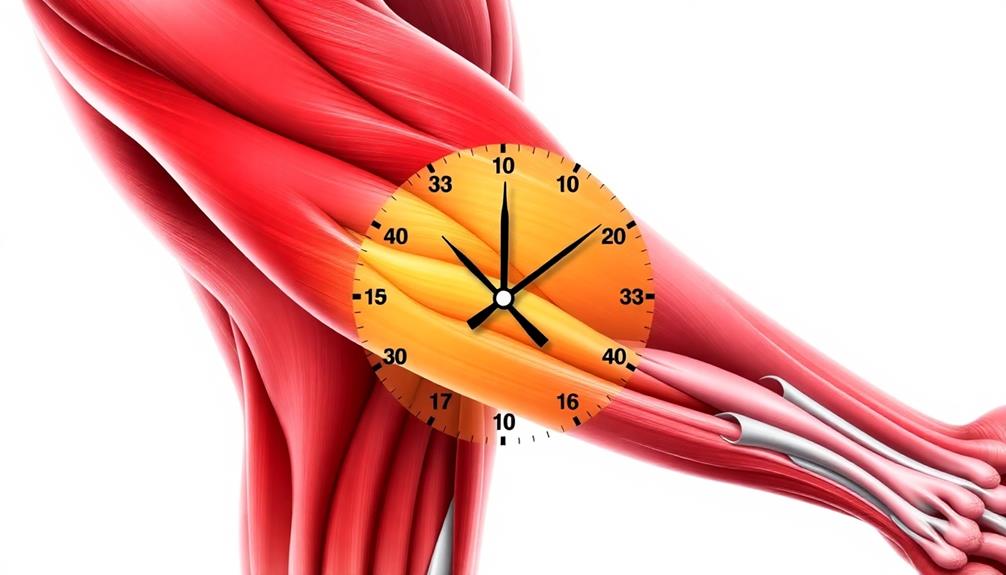Your muscle soreness recovery typically follows a five-day timeline after an intense workout. Day 0 brings immediate post-exercise effects like fatigue and increased heart rate. Days 1-2 mark the peak soreness phase, where muscles feel stiff and painful. By days 3-4, you'll experience gradual relief with improved range of motion. Recovery accelerates on days 5-6, allowing for light exercise and stretching. Around day 7, you'll return to baseline, ready to resume your usual routine. Throughout this process, stay hydrated, get enough sleep, and eat protein-rich foods. Understanding this timeline can help you optimize your recovery and prevent future soreness.
Core Insight
- Immediate post-exercise effects include muscle fatigue, increased heart rate, and sweating, lasting a few hours.
- Peak soreness typically occurs 24-72 hours after exercise, with stiff and painful muscles.
- Gradual relief begins after peak soreness, with improved range of motion and reduced pain.
- Recovery acceleration involves light exercise, protein-rich foods, hydration, and adequate sleep.
- Return to baseline occurs when soreness subsides, allowing resumption of regular exercise routines.
Day 0: Immediate Post-Exercise Effects
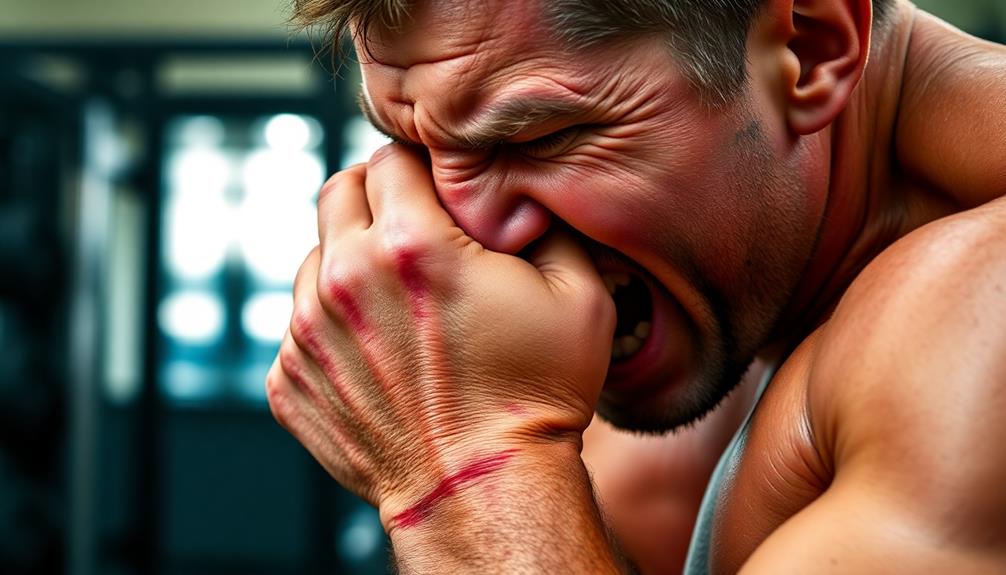
You'll feel tired right after a tough workout. Your muscles might be a bit sore. This is normal – you just pushed your body hard. You could have:
- Tired or shaky muscles
- Faster heart rate and breathing
- Sweat and higher body temperature
This won't last long, though. You'll likely feel better in a few hours. During this time, make sure to:
- Drink plenty of water to replace what you lost through sweat. Coconut water can be great after a workout because it has lots of electrolytes.
- Do some light stretches or easy movement to cool down.
- Eat a meal with both protein and carbs to refuel.
Your body is starting to recover now. Even if you're tired, your muscles are beginning to repair themselves. The next 24-48 hours are really important for your muscles to recover and get stronger.
Day 1-2: Peak Soreness Phase
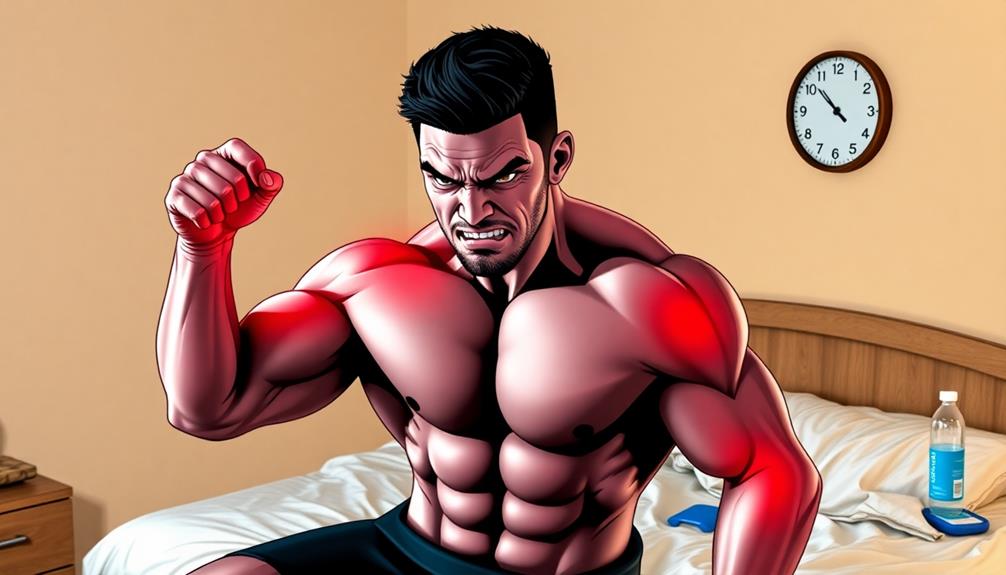
Your muscles hurt the most 1-2 days after a hard workout. This is called delayed onset muscle soreness, or DOMS. During this time, your muscles feel stiff, sore, and harder to move. It might be painful to move or touch the sore areas. Using a cooling towel can help you feel better and reduce swelling.
On these days, it's important to focus on gentle recovery. Light stretching, easy movement, and drinking lots of water can help you feel less sore. You can also use foam rollers or massage tools to gently work on the sore spots. But don't do intense exercise or heavy lifting during this time. It can make the soreness worse and might cause an injury. Remember, this soreness is normal and won't last forever. If you take care of yourself, you'll start feeling better soon.
Day 3-4: Gradual Relief Begins
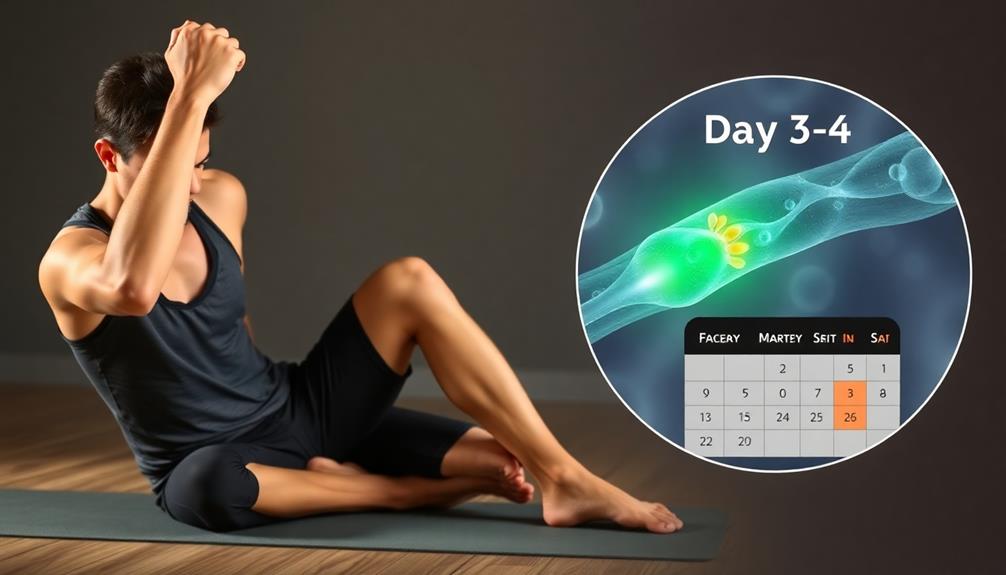
Days 3-4 bring gradual relief from muscle soreness. You'll feel less pain and stiffness as your body repairs the damaged muscle fibers and reduces inflammation. Foam rolling can help speed up recovery by targeting hard-to-reach areas and improving muscle flexibility.
During this phase, you can expect:
- Better range of motion
- Less pain during daily activities
- Improved muscle function
Keep moving gently and do light stretches to boost blood flow and help recovery. You can also start doing low-intensity exercises for the sore muscles. But don't overdo it – pay attention to your body and avoid pushing too hard.
Don't forget to drink plenty of water and eat a balanced diet with lots of protein and anti-inflammatory foods. This will support your body's healing process and help you move into the final stages of recovery.
Day 5-6: Recovery Acceleration
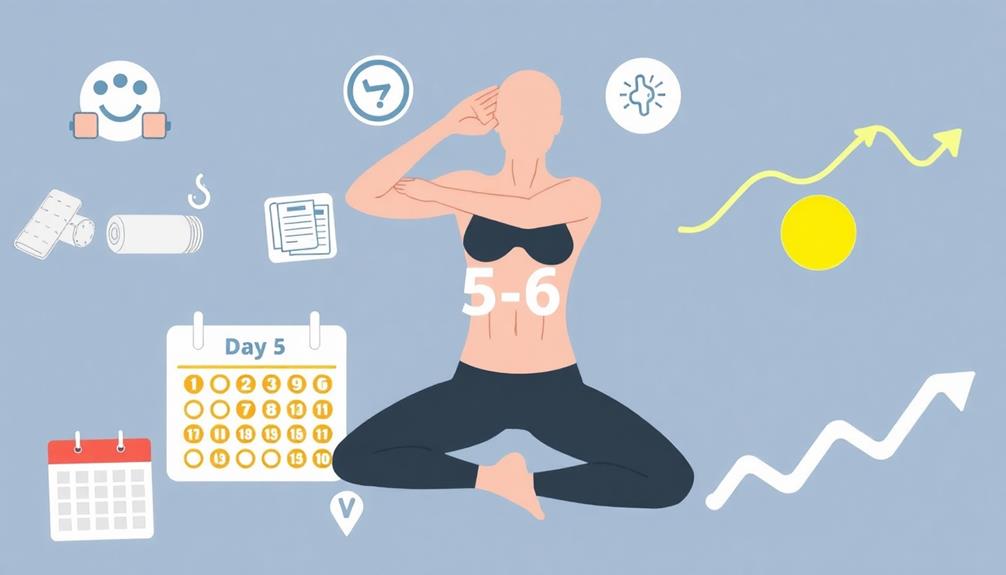
By days 5-6, you'll likely feel much better after being sore. You'll be able to move more easily and with less pain. This is a good time to start doing a bit more activity, but still take it easy.
Tips for days 5-6:
- Do light exercise and gentle stretches
- Eat foods with plenty of protein
- Drink lots of water
- Get 7-8 hours of sleep per night
During this time, you can slowly do harder exercises. But if anything hurts, do less. Everyone recovers at their own pace. Pay attention to how you feel and adjust if needed.
Day 7: Return to Baseline

By day 7, you should feel back to normal. Your muscles will no longer feel sore or stiff. You'll be able to move like you did before your workout. Now you're ready to get back to your usual exercise routine or try something new. Drinking coconut water after your workout can help you recover. It replaces electrolytes and helps your muscles feel better.
Keep in mind that your muscles have gotten used to the workout you did. This is how you get stronger and can exercise longer over time. But don't overdo it right away. Slowly make your workouts harder so you don't get really sore again.
Factors Affecting Recovery Speed
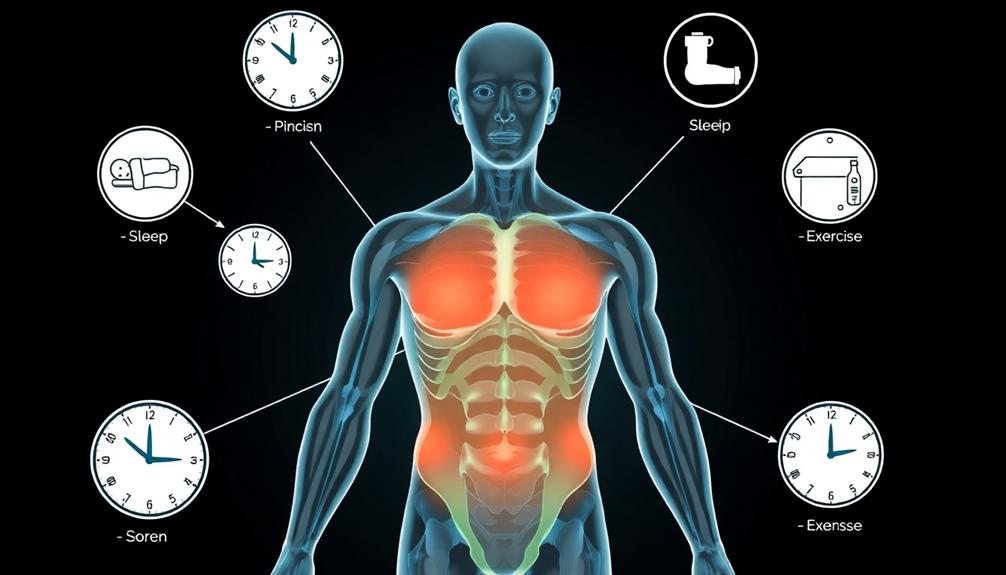
Quite a few things can change how fast your muscles bounce back from being sore. How old you are, how in shape you are, what you eat, and how well you sleep all matter a lot. The kind of exercise you did and how hard you worked also make a difference.
| Thing | How It Changes Recovery |
|---|---|
| Age | Older people might be slower to recover |
| Fitness | More fit people recover quicker |
| Food | Eating right helps you recover faster |
| Sleep | Sleeping well makes recovery better |
| Workout | Harder workouts can make recovery longer |
To recover as fast as you can, eat a diet with a good mix of protein and antioxidants. Get deep, restful sleep each night. Think about doing easy stretches or light workouts to stay moving. Drink plenty of water. Always warm up before and cool down after exercise. These things can help with sore muscles and get you back to normal in less time.
Strategies to Enhance Muscle Recovery

Simple Ways to Help Your Muscles Recover Faster
Getting your muscles to recover quickly is easy when you use the right methods. Follow these tips to speed things up:
- Drink lots of water to get rid of toxins and bring down swelling. Recovery drinks after a workout can also help you hydrate and give your body the nutrients it needs.
- Eat foods with plenty of protein to help fix and build your muscles.
- Do easy exercises to get your blood moving and loosen up stiff muscles.
- Stretch gently to make your muscles more flexible and less tense.
- Get enough good sleep so your body can heal and recharge.
- Use a foam roller or get a massage to work out muscle knots.
- Put ice on sore muscles to reduce swelling, then use heat to increase blood flow.
- Wear snug-fitting clothes to boost circulation and keep swelling down.
Frequently Asked Questions
Can Muscle Soreness Indicate a More Serious Injury?
Yes, muscle soreness can sometimes indicate a more serious injury. If you're experiencing severe pain, swelling, or limited range of motion that doesn't improve after a few days, you should consult a doctor for proper evaluation.
Does Age Affect the Muscle Soreness Recovery Timeline?
Yes, age does affect your muscle soreness recovery timeline. As you get older, you'll likely experience longer recovery periods. Your body's ability to repair and regenerate muscle tissue slows down, so you'll need more time between workouts.
Are Certain Muscle Groups More Prone to Prolonged Soreness?
Yes, certain muscle groups are more prone to prolonged soreness. You'll often find that larger muscles like your quads, hamstrings, and glutes take longer to recover. Your back muscles can also experience extended soreness after intense workouts.
How Does Sleep Quality Impact Muscle Soreness Recovery?
Sleep quality greatly impacts your muscle soreness recovery. When you're well-rested, your body repairs tissues more effectively. You'll experience faster healing, reduced inflammation, and improved muscle function. Prioritize quality sleep to speed up your recovery process.
Can Supplements Effectively Reduce the Duration of Muscle Soreness?
You'll find some supplements can help reduce muscle soreness duration. Omega-3s, antioxidants, and protein powders may speed up recovery. However, their effectiveness varies among individuals. It's best to consult a healthcare professional before starting any supplement regimen.

